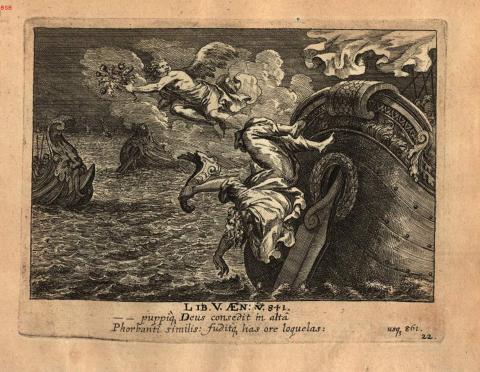Annotations
Palinurus falls from the stern of a ship into the sea, the God of Sleep flies away with a branch in his hand.
Palinurus stürzt vom Heck eines Schiffes ins Meer, der Schlafgott mit einem Zweig in der Hand fliegt davon. (Suerbaum)
Engraving from a German children’s picture-book version of the Aeneid by G. J. Lang and G. C. Eimmart, “A tapestry of Roman virtues as seen in Vergil’s Aeneas and his brave deeds, rendered in sparkling engravings, as illustrations of the remarkable deeds of antiquity, for the common benefit of noble youth,” (Peplus virtutum Romanarum in Aenea Virgiliano eiusque rebus fortiter gestis, ad maiorem antiquitatis et rerum lucem, communi iuventutis sacratae bono, aere renitens) (Nuremburg: J.L. Buggel, 1688), pl. 22.
Online Resources
Associated Passages
License
Creative Commons Attribution-NonCommercial-ShareAlike
Properties
Agent
Date
1688
Culture
Medium
Dimensions
21.86x16.92cm
Inscription
Lib. V. Aen: v. 841. -- puppique Deus consedit in alta/ Phorbanti similis: fuditque has ore loquelas:
Location
Bavarian State Library, Munich
Image Credit


This engraving captures the moment in Book V when Palinurus falls headfirst from the ship. The god of sleep first tried to convince the helmsman to take a nap by imitating a friend (841-846). When that failed he used the branch that can be seen in his hand as he flies away, the leaves of which are drenched in water from the river Lethe. Virgil says, “ecce deus ramum Lethaeo rore madentem/ vique soporatum Stygia super utraque quassat/ tempora, cunctantique natantia lumina solvit.” (Lucy McInerney)